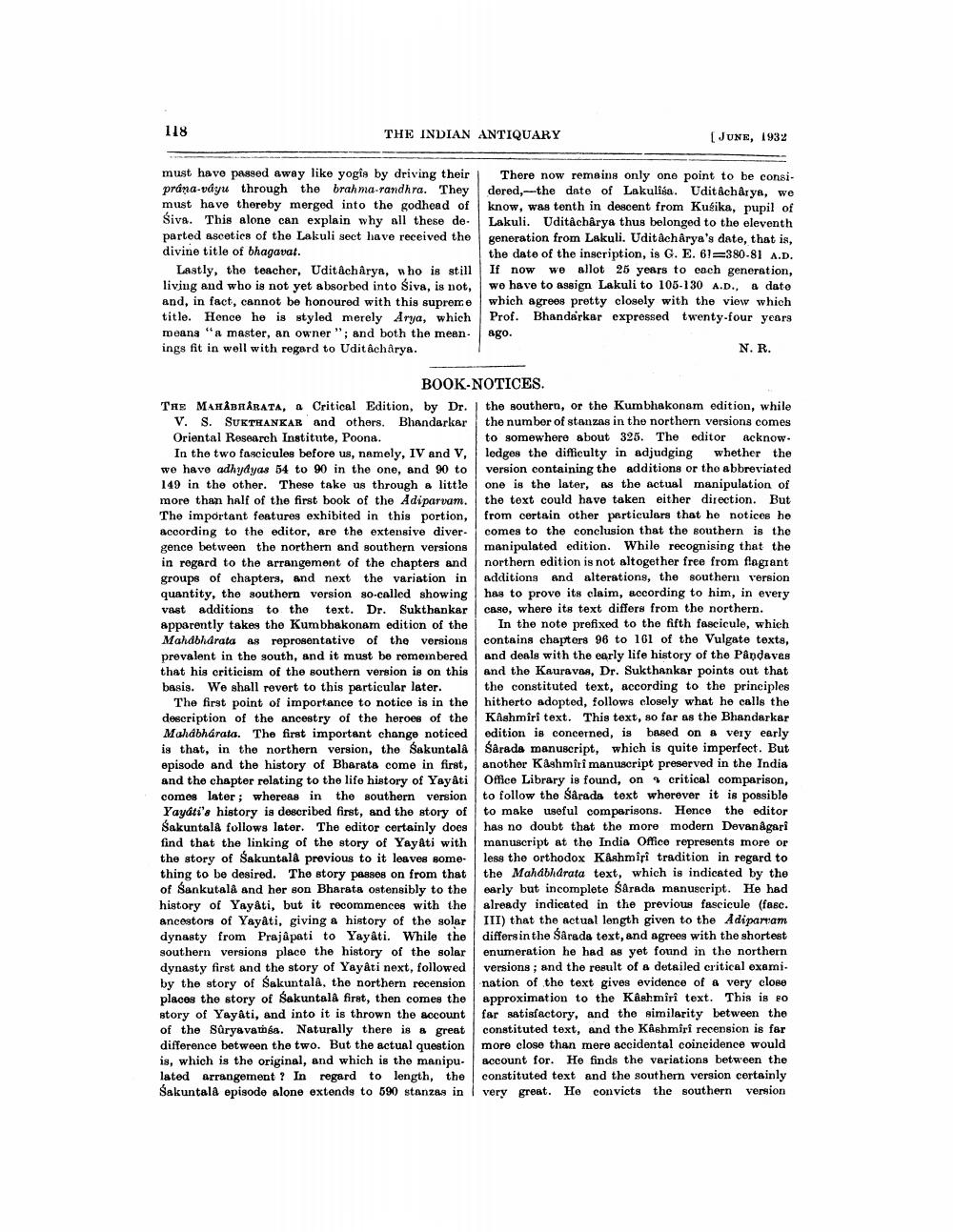________________
118
THE INDIAN ANTIQUARY
must have passed away like yogis by driving their prana-vayu through the brahma-randhra. They must have thereby merged into the godhead of Siva. This alone can explain why all these de. parted ascetics of the Lakuli sect have received the divine title of bhagavat.
Lastly, the teacher, Uditâchârya, who is still living and who is not yet absorbed into Śiva, is not, and, in fact, cannot be honoured with this supreme title. Hence he is styled merely Arya, which means "a master, an owner"; and both the meanings fit in well with regard to Uditâcharya.
BOOK-NOTICES.
THE MAHABHARATA, a Critical Edition, by Dr. V. S. SUKTHANKAR and others. Bhandarkar Oriental Research Institute, Poona.
In the two fascicules before us, namely, IV and V, we have adhyayas 54 to 90 in the one, and 90 to 149 in the other. These take us through a little more than half of the first book of the Adiparvam. The important features exhibited in this portion, according to the editor, are the extensive divergence between the northern and southern versions in regard to the arrangement of the chapters and groups of chapters, and next the variation in quantity, the southern version so-called showing vast additions to the text. Dr. Sukthankar apparently takes the Kumbhakonam edition of the Mahabharata as reprosentative of the versions prevalent in the south, and it must be remembered that his criticism of the southern version is on this basis. We shall revert to this particular later.
The first point of importance to notice is in the description of the ancestry of the heroes of the Mahabharata. The first important change noticed is that, in the northern version, the Sakuntala episode and the history of Bharata come in first, and the chapter relating to the life history of Yayâti comes later; whereas in the southern version Yayati's history is described first, and the story of Sakuntala follows later. The editor certainly does find that the linking of the story of Yayati with the story of Sakuntala previous to it leaves something to be desired. The story passes on from that of Sankutalå and her son Bharata ostensibly to the history of Yayâti, but it recommences with the ancestors of Yayati, giving a history of the solar dynasty from Prajapati to Yayâti. While the southern versions place the history of the solar dynasty first and the story of Yayâti next, followed by the story of Sakuntala, the northern recension places the story of Sakuntalâ first, then comes the story of Yayâti, and into it is thrown the account of the Sûryavainsa. Naturally there is a great difference between the two. But the actual question is, which is the original, and which is the manipu lated arrangement? In regard to length, the Sakuntala episode alone extends to 590 stanzas in
[JUNE, 1932
There now remains only one point to be considered, the date of Lakulisa. Uditâchârya, we know, was tenth in descent from Kusika, pupil of Lakuli. Uditâchârya thus belonged to the eleventh generation from Lakuli. Uditâchârya's date, that is, the date of the inscription, is G. E. 61-380-81 A.D. If now we allot 25 years to each generation, we have to assign Lakuli to 105-130 A.D., a dato which agrees pretty closely with the view which Prof. Bhandarkar expressed twenty-four years
ago.
N. R.
the southern, or the Kumbhakonam edition, while the number of stanzas in the northern versions comes to somewhere about 325. The editor acknow. ledges the difficulty in adjudging whether the version containing the additions or the abbreviated one is the later, as the actual manipulation of the text could have taken either direction. But from certain other particulars that he notices he comes to the conclusion that the southern is the manipulated edition. While recognising that the northern edition is not altogether free from flagrant additions and alterations, the southern version has to prove its claim, according to him, in every case, where its text differs from the northern.
In the note prefixed to the fifth fascicule, which contains chapters 96 to 161 of the Vulgate texts, and deals with the early life history of the Pandavas and the Kauravas, Dr. Sukthankar points out that the constituted text, according to the principles hitherto adopted, follows closely what he calls the Kashmiri text. This text, so far as the Bhandarkar edition is concerned, ist based on a very early Sarada manuscript, which is quite imperfect. But another Kashmiri manuscript preserved in the India Office Library is found, on critical comparison, to follow the Sarada text wherever it is possible. to make useful comparisons. Hence the editor has no doubt that the more modern Devanagari manuscript at the India Office represents more or less the orthodox Kâshmîrî tradition in regard to the Mahabharata text, which is indicated by the early but incomplete Sarada manuscript. He had already indicated in the previous fascicule (fasc. III) that the actual length given to the Adiparvam differs in the Sarada text, and agrees with the shortest enumeration he had as yet found in the northern versions; and the result of a detailed critical exami. nation of the text gives evidence of a very close approximation to the Kashmiri text. This is so far satisfactory, and the similarity between the constituted text, and the Kâshmîrî recension is far more close than mere accidental coincidence would account for. He finds the variations between the constituted text and the southern version certainly very great. He convicts the southern version




